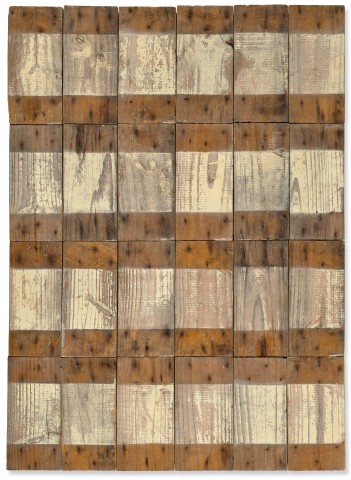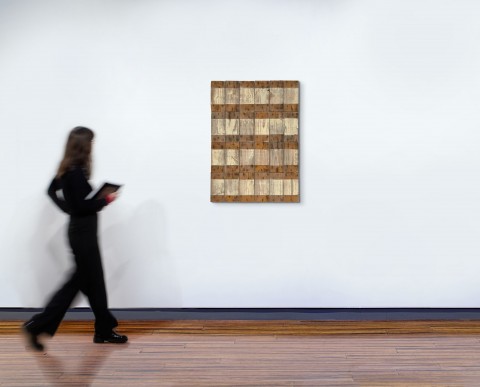WHITE AND GREY A, 1980
ROSALIE GASCOIGNE
painted wood from soft drink boxes on composition board
101.0 × 73.0 cm
The artist
Thence by descent
Private collection, Canberra
From the studio of Rosalie Gascoigne, Australian National University, Drill Hall Gallery, Canberra, 5 September - 12 November 2000, cat. 7 (as 'Untitled', c.1981)
Gascoigne, M., Rosalie Gascoigne. A Catalogue Raisonné, ANU Press, Canberra, 2019, cat. 191, pp. 196 (illus.), 348
The notion and practice of collecting were of vital importance to Rosalie Gascoigne and over the course of her relatively brief career she amassed vast material stockpiles of feathers, shells, dried grasses and wood, enamel kitchenware and linoleum, beer cans and dolls, and soft-drink crates and retro-reflective road-signs, which were to both become something of a signature material. Gascoigne’s avid fossicking was underpinned by extended periods of driving and exploring in the natural world surrounding Canberra and the unique and spare beauty of the region – and importantly, the experience of it – was to serve as a source of inspiration for much of her art. As she explained:
"Most of the things I use have been exposed to the weather and, in this sense, mine is an art of the outdoors. I like to use very ordinary material making do with whatever comes to hand within about a thirty mile radius of Canberra. I collect anything I like the look of, without having any particular plan for it at the time. I collect grey wood and faded colours and if there is a lot of anything I take it – a lot of it."1
The story of Rosalie Gascoigne is now almost the stuff of legend. Gascoigne had no formal art training, and first exhibited her work at the age of 57; after which she rapidly established a reputation as one of Australia’s foremost contemporary artists. Indeed, following her first exhibition at Canberra’s Macquarie Galleries in June 1974, Gascoigne subsequently developed an impressive exhibition history that included her being honoured, in 1982, as the first female artist to represent Australia at the Venice Biennale.2 While entirely self-taught, Gascoigne was to later acknowledge that her background in Sogetsu Ikebana3, and the introduction it provided to a sense of order and strong sculptural properties, had played a part in the development of her practice.4 Tellingly, Sogetsu also emphasises the importance of line and form over colour.
As White and Grey A, 1980 demonstrates, this sense of structure was to elegantly combine in Gascoigne’s work with the modern art historical notion of “the grid”, which became an important organising principle of many of her works made from soft-drink crates. In White and Grey A, Gascoigne aligns the components vertically so that the white paint on each board creates a strong (if slightly wonky) horizontal band; establishing a sense of continuum and endlessness, as if it could effectively extend forever. Unlike many of Gascoigne’s more ‘allusive and illusive’5 titles, that served to conjure images and associations when looking at her work, she allowed White and Grey A – through the simplicity of its title – to remain an abstraction. Part of the joy of this work, however, is the way in which her rudimentary materials fight back, proudly bearing their uneven edges and the scars and blemishes of their previous lives. Despite Gascoigne’s “will to order”, White and Grey A remains decidedly, and rewardingly, handmade.
1. Artist statement in Survey 2: Rosalie Gascoigne, National Gallery of Victoria, Melbourne, 1978, n.p.
2. Technically, Thea Proctor was the first Australian woman to have her work exhibited at the Venice Biennale, in 1912, but her work was shown as part of the British representation.
3. Founded by Sofu Teshigahara in 1927, Sogetsu embraces a philosophy that combines the naturalistic (and more traditional) approach to ikebana – that is, one that reflects the natural growth of the materials employed – with the expressionistic, as imbued in the subjective response of the arranger or “artist”.
4. Hawley, J., “A late developer”, Sydney Morning Herald (Good Weekend), Sydney, 15 November 1997, p. 42
5. Artist statement in Survey 2: Rosalie Gascoigne.
KELLY GELLATLY

